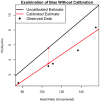Estimating energy expenditure from heart rate in older adults: a case for calibration
- PMID: 24787146
- PMCID: PMC4005766
- DOI: 10.1371/journal.pone.0093520
Estimating energy expenditure from heart rate in older adults: a case for calibration
Abstract
Background: Accurate measurement of free-living energy expenditure is vital to understanding changes in energy metabolism with aging. The efficacy of heart rate as a surrogate for energy expenditure is rooted in the assumption of a linear function between heart rate and energy expenditure, but its validity and reliability in older adults remains unclear.
Objective: To assess the validity and reliability of the linear function between heart rate and energy expenditure in older adults using different levels of calibration.
Design: Heart rate and energy expenditure were assessed across five levels of exertion in 290 adults participating in the Baltimore Longitudinal Study of Aging. Correlation and random effects regression analyses assessed the linearity of the relationship between heart rate and energy expenditure and cross-validation models assessed predictive performance.
Results: Heart rate and energy expenditure were highly correlated (r=0.98) and linear regardless of age or sex. Intra-person variability was low but inter-person variability was high, with substantial heterogeneity of the random intercept (s.d. =0.372) despite similar slopes. Cross-validation models indicated individual calibration data substantially improves accuracy predictions of energy expenditure from heart rate, reducing the potential for considerable measurement bias. Although using five calibration measures provided the greatest reduction in the standard deviation of prediction errors (1.08 kcals/min), substantial improvement was also noted with two (0.75 kcals/min).
Conclusion: These findings indicate standard regression equations may be used to make population-level inferences when estimating energy expenditure from heart rate in older adults but caution should be exercised when making inferences at the individual level without proper calibration.
Conflict of interest statement
Figures



References
-
- Manini TM, Everhart JE, Patel KV, Schoeller DA, Colbert LH, et al. (2006) Daily activity energy expenditure and mortality among older adults. JAMA 296: 171–179. - PubMed
-
- Wareham NJ, Hennings SJ, Prentice AM, Day NE (1997) Feasibility of heart-rate monitoring to estimate total level and pattern of energy expenditure in a population-based epidemiological study: The ely young cohort feasibility study 1994–5. British Journal of Nutrition 78: 889–900. - PubMed
-
- Neilson HK, Robson PJ, Friedenreich CM, Csizmadi I (2008) Estimating activity energy expenditure: How valid are physical activity questionnaires? The American Journal of Clinical Nutrition 87: 279–291. - PubMed
Publication types
MeSH terms
Grants and funding
LinkOut - more resources
Full Text Sources
Other Literature Sources

